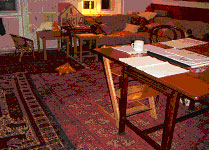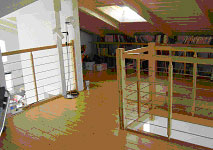Project Objectives
robots@home will provide an open mobile platform for the massive introduction of robots into
the homes of everyone. The emphasis is on providing easy-to-use modules that enable robot
navigation in everyday human environments. The breakthrough is based on three main innovations.
(1) The basic mechanical module as a scaleable mobile platform in response to the several and
different application scenarios such as security, facility management, care, service and personal robotics.
(2) A dependable and embedded perception module provides a multi-modal set of
sensor data for learning and mapping of the rooms and navigation through the environment.
And (3) the development of a safe and robust navigation method finally sets the case for using the platform in homes everywhere. Finally, perception, action and navigation are integrated and tested in typical home environments specified by the four industrial end users and in a furniture warehouse, e.g., IKEA. Developers as well as lay persons will show the robot around, indicate rooms and main items of furniture, give the robot time to investigate and certify the map, and then test the capabilities by commanding it to go, e.g., to the refrigerator, the dining table, or the bath tub.
It is the intended goal of the partners that the results of the robots@home project lead to a rapid introduction of the robots@home platform into commercial domestic robots and mobile service robotic systems. It will serve as an affordable, scaleable and versatile building block of robots that operate in environments presently not feasible, e.g., as depicted in Figure 1.
 |
 |
Fig. 1: Typical scenarios where the robots@home platform must navigate safely: table with
protruding,
chairs with slanted or thin metal legs,
toys, largely open balustrades, open space under a tilted roof, etc.
Technical Project Objectives
robots@home sets out to realise the necessary methods and modules for closing the existing technological gaps:
- Safe navigation method scaling to the diversity of home settings with many rooms, many items of furniture, many obstacles and high clutter,
- Robust perceptual and processing methods enabling to move from 2D navigation to coping with 3D structures and providing the capability to classify these structures,
- Embedded stereo vision system (ESVS) targeted for in-door usage providing dependable and dense stereo data at camera frame rate complementing sensing modalities such as intensity, colour, omni-vision, time-of-flight depth images and sonar sensors,
- Simple user interface for showing the robot around to obtain the room map and to annotate main items of furniture in the rooms, and
- Sizeable platform design and hardware ready to tackle the everyday home conditions.
Expected new Knowledge and Industrial Innovations
The envisioned solution is inspired by recent work in cognitive science, neuroscience and
animal navigation: a hierarchical cognitive map incorporates topological, metric and semantic
information. It builds on structural features observed in a newly developed
dependable embedded stereo vision system and complimented by time-of-flight
and sonar sensors. This approach has the potential to achieve the three more and
more challenging milestones, see Table below, leading up to the following industrial innovations:
- A generic mobile (robotic) platform as centre module for moving in homes world-wide and that can be sized according to the needs of different use cases provided by the market,
- Perceptual capabilities such that three-dimensional structures can be detected, classified and annotated, and that an appropriate reaction can be initialised to cope with all possible types of obstacles in home environments,
- A navigation method for a breakthrough in safe and dependable navigation in home environments 24 hours a day, 7 days a week,
- A simple-to-use and intuitive high-level command user interface for guiding the platform through the home and annotating the rooms and main pieces of furniture,
- Encapsulated methods as modules for easy reuse and integrated systems consisting of perceptual and navigation modules and the platform as required by applications and intelligent house environments.
- Evaluating the modules and the interface with the “Human-in-the-loop” paradigm, where the users not only specify the performance requirements but where they also test and evaluate the system and report problems and expectations for their everyday usage, and
- Disseminating and exploiting the platform and its modules in the use cases of four partners, attracting new commercial interests and addressing the public at large. It is targeted to commercialise the platform, the dependable perception system and the navigation module within two to three years after project end.
